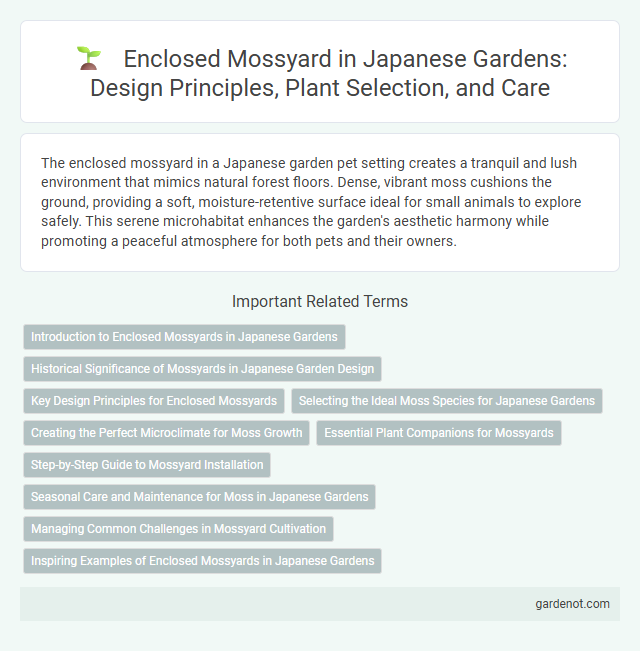The enclosed mossyard in a Japanese garden pet setting creates a tranquil and lush environment that mimics natural forest floors. Dense, vibrant moss cushions the ground, providing a soft, moisture-retentive surface ideal for small animals to explore safely. This serene microhabitat enhances the garden's aesthetic harmony while promoting a peaceful atmosphere for both pets and their owners.
Introduction to Enclosed Mossyards in Japanese Gardens
Enclosed mossyards in Japanese gardens are meticulously designed spaces featuring lush green moss that creates a serene and tranquil atmosphere. These gardens often incorporate stone pathways, water features, and carefully pruned trees to enhance the natural beauty and spiritual harmony of the moss-covered ground. The use of enclosed mossyards reflects traditional Japanese aesthetics emphasizing simplicity, subtlety, and a deep connection with nature.
Historical Significance of Mossyards in Japanese Garden Design
Enclosed mossyards in Japanese gardens represent centuries-old horticultural traditions reflecting the aesthetic principles of wabi-sabi and shoin-zukuri architecture. These moss-covered spaces symbolize tranquility and natural imperfection, often featuring in Zen gardens used for meditation and tea ceremonies during the Muromachi period. The preservation and cultivation of moss in these gardens demonstrate a deep cultural reverence for nature's subtle beauty and historical Japanese garden design philosophies.
Key Design Principles for Enclosed Mossyards
Enclosed mossyards emphasize the harmonious balance between natural elements and spatial boundaries, using moss to create textured, lush groundcover within defined perimeters. Key design principles include the careful selection of moss species suited to local climate and light conditions, strategic placement of stones to guide movement and visual flow, and the use of subtle elevation changes to add depth without disrupting tranquility. Maintaining simplicity and asymmetry fosters a serene atmosphere, inviting contemplation while honoring traditional Japanese aesthetics.
Selecting the Ideal Moss Species for Japanese Gardens
Selecting the ideal moss species for an enclosed mossyard in Japanese gardens involves considering factors like shade tolerance, moisture levels, and texture to achieve a serene, natural aesthetic. Popular moss varieties include Hypnum, Dicranum, and Leucobryum, each providing unique visual softness and vibrant green hues that thrive in humid, shaded environments. Proper moss selection enhances the garden's harmony, creating a tranquil ambiance that reflects traditional Japanese landscaping principles.
Creating the Perfect Microclimate for Moss Growth
An enclosed mossyard in a Japanese garden fosters a humid microclimate essential for vibrant moss growth by minimizing wind exposure and retaining moisture. Carefully positioned shade trees and stone arrangements regulate sunlight and temperature, preventing moss from drying out. Consistent humidity and filtered light encourage lush, green moss mats, enhancing the garden's serene atmosphere.
Essential Plant Companions for Mossyards
Essential plant companions for enclosed mossyards in Japanese gardens include shade-tolerant species such as ferns (Dryopteris erythrosora and Asplenium nidus), hostas, and small evergreen shrubs like azaleas (Rhododendron indicum). These plants thrive in moist, shaded environments, enhancing the tranquil ambiance while supporting moss health by maintaining humidity and sheltering delicate moss structures from direct sunlight. Incorporating evergreen ground covers like Sagina subulata alongside moss creates textural contrast and naturalistic harmony essential to authentic mossyard aesthetics.
Step-by-Step Guide to Mossyard Installation
Creating an enclosed mossyard requires selecting a shaded, moisture-retentive location with acidic, well-draining soil to support moss growth. Prepare the area by removing weeds and compacting the soil gently, then apply a thin layer of moss fragments or plugs, pressing them firmly into place for optimal contact. Maintain high humidity by regularly misting and avoiding direct sunlight to encourage moss establishment and lush, green coverage.
Seasonal Care and Maintenance for Moss in Japanese Gardens
Enclosed mossyards in Japanese gardens require precise seasonal care to maintain their vibrant green texture and prevent desiccation, especially during hot summers and freezing winters. Regular watering in dry periods and shading during peak sunlight are essential practices to preserve moss health and prevent bleaching or browning. Pruning surrounding plants to control humidity and removing fallen debris help sustain an optimal microenvironment for moss growth and longevity.
Managing Common Challenges in Mossyard Cultivation
Managing common challenges in enclosed mossyard cultivation requires controlling humidity levels to prevent mold growth and ensuring proper airflow to maintain moss health. Regular monitoring of soil pH and moisture content helps avoid fungal diseases and promotes vibrant moss development. Implementing shade management techniques reduces excessive sunlight exposure, crucial for sustaining the delicate balance of the moss ecosystem.
Inspiring Examples of Enclosed Mossyards in Japanese Gardens
Enclosed mossyards in Japanese gardens showcase exquisite examples of tranquility and natural elegance, such as the Saiho-ji (Moss Temple) in Kyoto, renowned for its lush, meticulously maintained moss carpets. These gardens highlight the interplay of stone, water, and moss, creating serene microcosms that embody wabi-sabi aesthetics. Their design principles emphasize subtle textures and varying shades of green, inspiring garden architects worldwide to replicate this harmonious blend of simplicity and depth.
Enclosed mossyard Infographic

 gardenot.com
gardenot.com